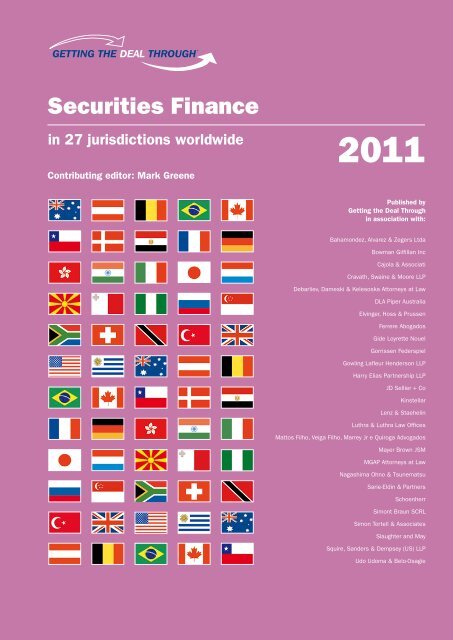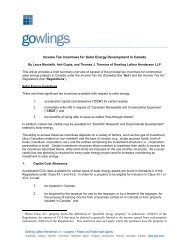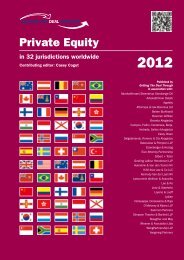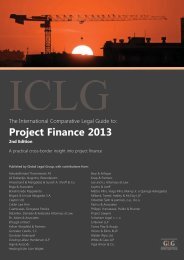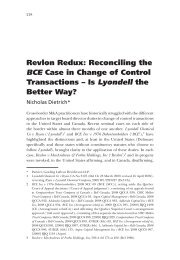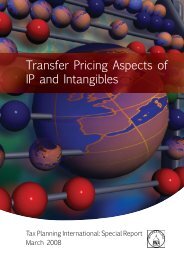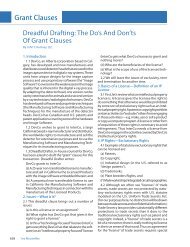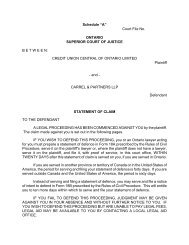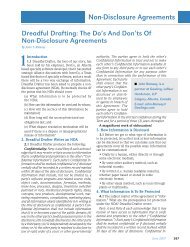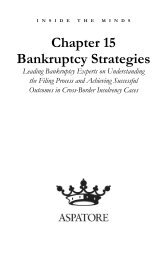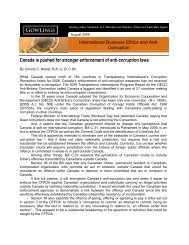Getting the Deal Through - Securities Finance 2011 - Gowlings
Getting the Deal Through - Securities Finance 2011 - Gowlings
Getting the Deal Through - Securities Finance 2011 - Gowlings
- No tags were found...
Create successful ePaper yourself
Turn your PDF publications into a flip-book with our unique Google optimized e-Paper software.
®<strong>Securities</strong> <strong>Finance</strong>in 27 jurisdictions worldwide<strong>2011</strong>Contributing editor: Mark GreenePublished by<strong>Getting</strong> <strong>the</strong> <strong>Deal</strong> <strong>Through</strong>in association with:Bahamondez, Alvarez & Zegers LtdaBowman Gilfillan IncCajola & AssociatiCravath, Swaine & Moore LLPDebarliev, Dameski & Kelesoska Attorneys at LawDLA Piper AustraliaElvinger, Hoss & PrussenFerrere AbogadosGide Loyrette NouelGorrissen FederspielGowling Lafleur Henderson LLPHarry Elias Partnership LLPJD Sellier + CoKinstellarLenz & StaehelinLuthra & Luthra Law OfficesMattos Filho, Veiga Filho, Marrey Jr e Quiroga AdvogadosMayer Brown JSMMGAP Attorneys at LawNagashima Ohno & TsunematsuSarie-Eldin & PartnersSchoenherrSimont Braun SCRLSimon Tortell & AssociatesSlaughter and MaySquire, Sanders & Dempsey (US) LLPUdo Udoma & Belo-Osagie
contents®<strong>Securities</strong> <strong>Finance</strong><strong>2011</strong>Contributing editor:Mark GreeneCravath Swaine & Moore LLPBusiness development managersAlan LeeGeorge IngledewRobyn He<strong>the</strong>ringtonDan WhiteMarketing managersEllie NotleySarah WalshMarketing assistantsAlice HazardWilliam BentleySarah SavageSubscriptions managerNadine RadcliffeSubscriptions@<strong>Getting</strong>The<strong>Deal</strong><strong>Through</strong>.comAssistant editorAdam MyersEditorial assistantLydia GergesSenior production editorJonathan CowieChief subeditorJonathan AllenSenior subeditorKathryn SmulandSubeditorsDavet HylandCaroline RawsonEditor-in-chiefCallum CampbellPublisherRichard Davey<strong>Securities</strong> <strong>Finance</strong> <strong>2011</strong>Published byLaw Business Research Ltd87 Lancaster RoadLondon, W11 1QQ, UKTel: +44 20 7908 1188Fax: +44 20 7229 6910© Law Business Research Ltd <strong>2011</strong>No photocopying: copyright licencesdo not apply.ISSN 1744-0939The information provided in thispublication is general and may not applyin a specific situation. Legal advice shouldalways be sought before taking any legalaction based on <strong>the</strong> information provided.This information is not intended tocreate, nor does receipt of it constitute, alawyer–client relationship. The publishersand authors accept no responsibility forany acts or omissions contained herein.Although <strong>the</strong> information provided isaccurate as of May <strong>2011</strong>, be advised thatthis is a developing area.Overview Mark Greene, Andrew Pitts and George Stephanakis Cravath, Swaine & Moore LLP 3Australia David Morris and Ca<strong>the</strong>rine Merity DLA Piper Australia 6Austria Ursula Rath and Christoph Moser Schoenherr 13Belgium Sandrine Hirsch and Vanessa Marquette Simont Braun SCRL 20Brazil Jean Marcel Arakawa and Vanessa FiusaMattos Filho, Veiga Filho, Marrey Jr e Quiroga Advogados 27Canada Eugene Chen, Martine Guimond, Brett A Kagetsu and Jason A SaltzmanGowling Lafleur Henderson LLP 32Chile Matías Zegers and Gonzalo Rivera Bahamondez, Alvarez & Zegers Ltda 41Denmark Søren Fogh and Michael Steen Jensen Gorrissen Federspiel 46Egypt Motaz Eldreny Sarie-Eldin & Partners 51France Arnaud Duhamel Gide Loyrette Nouel 56Germany Andreas Fillmann and Jörg Uhlmann Squire, Sanders & Dempsey (US) LLP 62Hong Kong Patrick Wong and Noella Chow Mayer Brown JSM 72India The <strong>Securities</strong> and <strong>Finance</strong> Team Luthra & Luthra Law Offices 78Italy Riccardo G Cajola Cajola & Associati 84Japan Masatsura Kadota and Shinichi Araki Nagashima Ohno & Tsunematsu 90Luxembourg Philippe Hoss Elvinger, Hoss & Prussen 95Macedonia Elena Miceva and Dragan Dameski Debarliev Dameski & Kelesoska Attorneys at Law 101Malta Simon Tortell, Adrian Cutajar and Nicholas Micallef Simon Tortell & Associates 105Nigeria Yinka Edu Udo Udoma & Belo-Osagie 109Russia Svetlana London and Alexander Yurchik MGAP Attorneys at Law 114Singapore Claudia Teo and Douglas Koh Harry Elias Partnership LLP 119South Africa Ezra Davids, David Yuill and Ryan Wessels Bowman Gilfillan Inc 125Switzerland Jacques Iffland and Patrick Schleiffer Lenz & Staehelin 133Trinidad and Tobago William David Clarke and Donna-Marie Johnson JD Sellier + Co 138Turkey Halide Cetinkaya, Gamze Cigdemtekin and Tuna Cakirca Kinstellar 143United Kingdom Peter Brien and Daniel Won Slaughter and May 149United States Mark Greene, Andrew Pitts and George Stephanakis Cravath, Swaine & Moore LLP 157Uruguay Diego Rodríguez Ferrere Abogados 165Printed and distributed byEncompass Print SolutionsTel: 0844 2480 112LawBusinessResearch
CanadaGowling Lafleur Henderson LLPCanadaEugene Chen, Martine Guimond, Brett A Kagetsu and Jason A SaltzmanGowling Lafleur Henderson LLPStatutes and regulations1 What are <strong>the</strong> relevant statutes and regulations governing securitiesofferings? Which regulatory authority is primarily responsible for <strong>the</strong>administration of those rules?Each of Canada’s 13 provinces and territories has its own securitieslaws and, despite recent efforts to harmonise this legislationacross Canada, <strong>the</strong> issuance of securities to Canadian investors iscurrently governed by <strong>the</strong> securities laws of <strong>the</strong> province or territoryin which <strong>the</strong> Canadian investor resides and, in certain jurisdictions,also where <strong>the</strong> issuer’s head office is located. Generally, each provinceand territory has a securities act and related regulations, includingharmonised national and multilateral instruments enacted throughregulation and associated companion policies. This article assumesthat prospective investors of securities are resident in <strong>the</strong> provinces ofOntario, British Columbia, Alberta or Québec. If securities are soldto investors in o<strong>the</strong>r Canadian provinces or territories, a review ofsuch jurisdiction’s securities laws will be required in order to confirmwhe<strong>the</strong>r <strong>the</strong>re are any different or additional requirements.The securities regulatory authorities in each province and territorythat are primarily responsible for <strong>the</strong> administration of localsecurities laws are:Province or TerritoryBritish ColumbiaAlbertaSaskatchewanManitobaOntarioQuébecNew BrunswickNova ScotiaPrince Edward IslandNewfoundland and LabradorYukonNorthwest TerritoriesNunavut<strong>Securities</strong> Regulatory AuthorityBritish Columbia <strong>Securities</strong> CommissionAlberta <strong>Securities</strong> CommissionSaskatchewan Financial ServicesCommissionManitoba <strong>Securities</strong> CommissionOntario <strong>Securities</strong> CommissionAutorité des marchés financiersNew Brunswick <strong>Securities</strong> CommissionNova Scotia <strong>Securities</strong> Commission<strong>Securities</strong> Office - Prince Edward IslandDepartment of Government Services,Consumer & Commercial Affairs Branch,Newfoundland and LabradorSuperintendent of <strong>Securities</strong>,Government of YukonSuperintendent of <strong>Securities</strong>,Government of Northwest TerritoriesSuperintendent of <strong>Securities</strong>,Government of NunavutThe provincial and territorial securities regulatory authorities havealso formed a voluntary umbrella organisation called <strong>the</strong> Canadian<strong>Securities</strong> Administrators (CSA) that is primarily responsible fordesigning policies and regulations that are consistent across Canadaand for ensuring <strong>the</strong> smooth operation of Canada’s securitiesindustry.The o<strong>the</strong>r key regulatory authorities in Canada that play a rolein <strong>the</strong> governance of securities offerings are <strong>the</strong> Investment IndustryRegulatory Organisation of Canada (IIROC) and <strong>the</strong> Mutual Fund<strong>Deal</strong>ers Association of Canada (MFDA), both of which have beenrecognised as self-regulatory organisations by <strong>the</strong> securities regulatoryauthorities in Canada. IIROC’s role is to oversee all investmentdealers, as well as trading activity on debt and equity marketplacesin Canada, and <strong>the</strong> MFDA’s role is to oversee all mutual fund dealersoperating in Canada.Finally, <strong>the</strong> principal stock exchanges in Canada, being <strong>the</strong>Toronto Stock Exchange (TSX) and <strong>the</strong> TSX Venture Exchange(TSXV), also have rules and policies applicable to issuers listed onthose exchanges and to member investment dealers, which are relevantto securities offerings.Public offerings2 What regulatory or stock exchange filings must be made in connectionwith a public offering of securities? What information must beincluded in such filings or made available to potential investors?Primary offeringsAn issuer wishing to make a public offering of securities in Canadadoes so by preparing and filing a preliminary prospectus with <strong>the</strong>securities regulators in <strong>the</strong> provinces and territories in which <strong>the</strong>offering is to be made and with <strong>the</strong> stock exchange on which itdesires to list its securities. In Canada, <strong>the</strong> vast majority of issuersare listed on <strong>the</strong> TSX or <strong>the</strong> TSXV. After addressing <strong>the</strong> commentsof Canadian securities regulators and obtaining conditional approvalof <strong>the</strong> TSX or TSXV, <strong>the</strong> issuer files a final prospectus and obtains adecision document that allows <strong>the</strong> securities to be qualified for saleto <strong>the</strong> public. The prospectus performs two functions. First, it is usedby <strong>the</strong> issuer and <strong>the</strong> underwriters as a marketing document for <strong>the</strong>offering. Second, it is required to provide potential investors with‘full, true and plain disclosure of all material facts’ relating to <strong>the</strong>securities being offered for sale.General prospectus requirements are governed by NationalInstrument 41-101 General Prospectus Requirements (NI 41-101).For eligible reporting issuers with certain required informationalready filed with <strong>the</strong> securities regulators and publicly available,an issuer may conduct an offering of securities by preparing a shortform prospectus in accordance with National Instrument 44-101Short Form Prospectus Distributions (NI 44-101). An issuer mayalso prepare a shelf prospectus in accordance with National Instrument44-102 Shelf Distributions, which is a prospectus that is filedand put on a ‘shelf’ (for up to 25 months) until <strong>the</strong> issuer takes someor all of <strong>the</strong> qualified securities ‘off <strong>the</strong> shelf’ for distribution. At <strong>the</strong>time of <strong>the</strong> sale, <strong>the</strong> issuer must file a shelf prospectus supplementto ensure that <strong>the</strong> subscribers are provided with full, true and plaindisclosure of all material facts relating to <strong>the</strong> securities being offeredfor sale at that time.32 <strong>Getting</strong> <strong>the</strong> <strong>Deal</strong> <strong>Through</strong> – <strong>Securities</strong> <strong>Finance</strong> <strong>2011</strong>
CanadaGowling Lafleur Henderson LLPsecurities regulators and <strong>the</strong> receipt for such final prospectus hasbeen received by <strong>the</strong> issuer. Once a preliminary prospectus is filed,<strong>the</strong> principal regulator will typically take up to three business days toreview and provide <strong>the</strong>ir comments on <strong>the</strong> preliminary prospectus.The general steps for filing a prospectus in a ‘bought deal’ publicoffering are as follows:• <strong>the</strong> issuer and <strong>the</strong> lead underwriter enter into an enforceableagreement and <strong>the</strong> issuer issues a press release;• <strong>the</strong> underwriters solicit expressions of interest;• within four business days of <strong>the</strong> date of <strong>the</strong> enforceable agreement,<strong>the</strong> issuer files <strong>the</strong> preliminary prospectus along withrelated materials (including an underwriting agreement) and isreceipted <strong>the</strong> same day provided that <strong>the</strong> materials are filed byearly afternoon;• <strong>the</strong> principal regulator generally takes three business days toreview and provide its first comment letter to <strong>the</strong> issuer;• a response letter along with a ‘blackline’ of <strong>the</strong> final prospectusto <strong>the</strong> preliminary prospectus is filed evidencing all revisions to<strong>the</strong> preliminary prospectus;• assuming all of <strong>the</strong> principal regulator’s concerns are addressedin <strong>the</strong> response letter, <strong>the</strong> issuer receives clearance to file <strong>the</strong> finalprospectus and related materials;• if <strong>the</strong> principal regulator’s concerns are not fully addressed, <strong>the</strong>principal regulator will issue a second comment letter withinthree business days and <strong>the</strong> process repeats until all of <strong>the</strong> principalregulator’s concerns are addressed;• once <strong>the</strong> issuer receives clearance to file <strong>the</strong> final prospectus, <strong>the</strong>final prospectus along with <strong>the</strong> related materials are filed and <strong>the</strong>issuer is receipted; and• <strong>the</strong> issuer and <strong>the</strong> underwriters proceed to <strong>the</strong> closing of <strong>the</strong> publicoffering.The general steps for filing a prospectus in a ‘fully marketed’ or ‘bestefforts’ public offering are as follows:• <strong>the</strong> issuer and <strong>the</strong> lead underwriter or agent enter into a bindingengagement agreement;• <strong>the</strong> issuer files <strong>the</strong> preliminary prospectus along with relatedmaterials and is receipted <strong>the</strong> same day provided that <strong>the</strong> materialsare filed no later than <strong>the</strong> early afternoon;• <strong>the</strong> principal regulator generally takes three business days toreview and provide its first comment letter to <strong>the</strong> issuer;• a response letter along with a ‘blackline’ of <strong>the</strong> final prospectusto <strong>the</strong> preliminary prospectus is filed;• if all of <strong>the</strong> principal regulator’s concerns are addressed in <strong>the</strong>response letter, <strong>the</strong> issuer receives clearance to file <strong>the</strong> final prospectusand related materials;• if <strong>the</strong> principal regulator’s concerns are not fully addressed, <strong>the</strong>principal regulator will issue a second comment letter withinthree business days and <strong>the</strong> process repeats until all of <strong>the</strong> principalregulator’s concerns are addressed;• during <strong>the</strong> time that <strong>the</strong> principal regulator is reviewing <strong>the</strong> preliminaryprospectus, <strong>the</strong> underwriters or agents will pre-market<strong>the</strong> offered securities and build <strong>the</strong> ‘book’ and will negotiate anunderwriting or agency agreement with <strong>the</strong> issuer;• once <strong>the</strong> issuer receives clearance to file <strong>the</strong> final prospectus, <strong>the</strong>final prospectus along with <strong>the</strong> related materials (including <strong>the</strong>underwriting or agency agreement) are filed and <strong>the</strong> issuer isreceipted;• <strong>the</strong> issuer will issue a press release regarding <strong>the</strong> entering into ofan underwriter or agency agreement and <strong>the</strong> filing of <strong>the</strong> finalprospectus; and• <strong>the</strong> issuer and <strong>the</strong> underwriters or agents proceed to <strong>the</strong> closingof <strong>the</strong> public offering.The timelines outlined for responses by regulators in <strong>the</strong> precedingparagraphs are applicable for a short form prospectus filed under NI44-101 where <strong>the</strong> issuer is incorporating <strong>the</strong> majority of its materialinformation into <strong>the</strong> prospectus from documents that are filed andpublicly available (eg, its annual information form, press releases,material change reports and financial statements). For a long formprospectus filed under NI 41-101, <strong>the</strong> regulator’s response times willbe significantly longer, generally 10 business days for a first commentletter.4 What publicity restrictions apply to a public offering of securities?Are <strong>the</strong>re any restrictions on <strong>the</strong> ability of <strong>the</strong> underwriters to issueresearch reports?The Canadian securities regulators recommend certain practices thatparticipants in prospectus distributions should consider to avoidcontravening securities legislation in <strong>the</strong> Companion Policy to NI41-101. In addition, to ensure that advertising or marketing activitiesare carried out in compliance with <strong>the</strong> prospectus requirements,participants must ensure that any statements made in <strong>the</strong> course ofadvertising or marketing activities are not untrue or misleading ando<strong>the</strong>rwise comply with securities legislation. Fur<strong>the</strong>rmore, unless anexemption from <strong>the</strong> registration requirement is available, advertisingor marketing activities may be made only by a person or companywho is registered in <strong>the</strong> appropriate category.Prior to issuance of preliminary receiptIn general, any advertising or marketing activities undertaken in connectionwith a prospectus prior to <strong>the</strong> issuance of a receipt for <strong>the</strong>preliminary prospectus are prohibited under securities legislation byvirtue of <strong>the</strong> prospectus requirement. This applies to any act, advertisement,solicitation, conduct or negotiation directly or indirectlyin fur<strong>the</strong>rance of a distribution unless a prospectus exemption isavailable.During <strong>the</strong> waiting period<strong>Securities</strong> legislation provides an exception to <strong>the</strong> prospectus requirementfor limited advertising or marketing activities during <strong>the</strong> waitingperiod between <strong>the</strong> issuance of <strong>the</strong> receipt for <strong>the</strong> preliminaryprospectus and <strong>the</strong> receipt for <strong>the</strong> final prospectus, including:• <strong>the</strong> distribution of notices, circulars, advertisements, letters oro<strong>the</strong>r communications that ‘identify’ <strong>the</strong> securities proposed tobe issued, state <strong>the</strong> price of such securities and state <strong>the</strong> nameand address of a person or company from whom purchases ofsecurities may be made;• <strong>the</strong> distribution of <strong>the</strong> preliminary prospectus; and• <strong>the</strong> solicitation of expressions of interest from a prospective purchaser,if prior to such solicitation or forthwith after <strong>the</strong> prospectivepurchaser indicates an interest in purchasing <strong>the</strong> securities, acopy of <strong>the</strong> preliminary prospectus is forwarded to such prospectivepurchaser. Any communications used in connection with aprospectus offering during <strong>the</strong> waiting period must contain alegend prescribed by NI 41-101.After <strong>the</strong> issuance of <strong>the</strong> final receiptAdvertising or marketing activities that are not prohibited by <strong>the</strong>prospectus requirement during <strong>the</strong> waiting period may also be undertakenon <strong>the</strong> same basis after a receipt has been issued for <strong>the</strong> finalprospectus relating to <strong>the</strong> distribution. In addition, <strong>the</strong> prospectusand any document filed with or referred to in <strong>the</strong> prospectus may bedistributed. Any communications used in connection with a prospectusoffering following <strong>the</strong> issuance of a final receipt must contain alegend prescribed by NI 41-101.5 Are <strong>the</strong>re any special rules that differentiate between primary andsecondary offerings? What are <strong>the</strong> liability issues for <strong>the</strong> seller ofsecurities in a secondary offering?As discussed under question 2, under a secondary offering, <strong>the</strong> sellingsecurityholders use <strong>the</strong> same prospectus to sell <strong>the</strong>ir securities as34 <strong>Getting</strong> <strong>the</strong> <strong>Deal</strong> <strong>Through</strong> – <strong>Securities</strong> <strong>Finance</strong> <strong>2011</strong>
Gowling Lafleur Henderson LLPCanada<strong>the</strong> company uses to offer newly issued securities. However, eventhough <strong>the</strong> prospectus is prepared by <strong>the</strong> issuer and its advisers, sellingsecurityholders have statutory liability for a misrepresentation in<strong>the</strong> prospectus and will be jointly and severally liable with <strong>the</strong> issuer(and certain o<strong>the</strong>r parties) for <strong>the</strong> full amount of <strong>the</strong> offering, without<strong>the</strong> benefit of a due diligence defence. To limit potential exposure, aselling securityholder may seek indemnities from <strong>the</strong> issuer and o<strong>the</strong>rselling securityholders.In certain circumstances, under a permitted secondary offering,a principal may sell all or any portion of <strong>the</strong> securities that it held at<strong>the</strong> time of <strong>the</strong> public offering free of escrow, which must be disclosedin <strong>the</strong> prospectus. Any of <strong>the</strong> principal’s unsold escrow securities willcontinue to be subject to escrow.A secondary distribution of securities is permitted to be effectedpursuant to a prospectus offering through <strong>the</strong> facilities of <strong>the</strong> TSX or<strong>the</strong> TSXV. Under <strong>the</strong> policies of <strong>the</strong> TSXV, if an offering consists ofboth a primary and a secondary distribution, <strong>the</strong> primary distributionmust be completed before <strong>the</strong> commencement of <strong>the</strong> secondarydistribution and <strong>the</strong> price of <strong>the</strong> secondary distribution must be <strong>the</strong>same as <strong>the</strong> primary distribution. The selling securityholders of anysecondary offering must bear a proportionate share of <strong>the</strong> agent’scommission and offering costs. The TSX does not set out any specificrequirements regarding a secondary distribution.6 What is <strong>the</strong> typical settlement process for sales of securities in apublic offering?Generally, <strong>the</strong>re are two types of settlement processes for a sale ofsecurities in a public offering in Canada. Traditionally, <strong>the</strong> processhas been to have <strong>the</strong> issuer issue a physical global certificate representing<strong>the</strong> aggregate shares issued under <strong>the</strong> public offering, registeredin <strong>the</strong> name of ‘CDS & Co’, which will get directly depositedwith CDS Clearing and Depository Services Inc (CDS) by a participant(usually <strong>the</strong> transfer agent of <strong>the</strong> issuer) immediately following<strong>the</strong> closing of <strong>the</strong> public offering. CDS will <strong>the</strong>n credit <strong>the</strong> lead underwriter’saccount with <strong>the</strong> number of shares shown on <strong>the</strong> certificate.More recently, <strong>the</strong> settlement for public offerings has been done on a‘book-entry only’ basis where <strong>the</strong> lead underwriter will electronicallyset up its deposit account with CDS using <strong>the</strong> CUSIP (Committee onUniform Security Identification Procedures) number of <strong>the</strong> issuer’ssecurities and provide <strong>the</strong> deposit information to <strong>the</strong> transfer agent sothat it can be electronically deposited directly by <strong>the</strong> transfer agent to<strong>the</strong> account of <strong>the</strong> lead underwriter through <strong>the</strong> facilities of CDS.Private placings7 Are <strong>the</strong>re specific rules for <strong>the</strong> private placing of securities? Whatprocedures must be implemented to effect a valid private placing?Private placements are sales of securities effected by means of exemptionsfrom <strong>the</strong> legal requirement to file and deliver a prospectus to<strong>the</strong> public. National Instrument 45-106 Prospectus and RegistrationExemptions and Regulation 45-106 Respecting Prospectus andRegistration Exemptions in Québec (collectively, NI 45-106) are <strong>the</strong>applicable regulatory instruments for private placements in Canada.It is <strong>the</strong> issuer’s responsibility to ensure that it is issuing securities toinvestors in compliance with applicable securities laws.NI 45-106 describes various private placement exemptions. Themost commonly used prospectus exemption by issuers for privateplacements in Canada is <strong>the</strong> ‘accredited investor’ exemption. O<strong>the</strong>rprospectus exemptions under NI 45-106 may be available to issuerswhen certain specific criteria are met. This section summarises <strong>the</strong>more relevant exemptions that issuers use.Accredited investor exemptionWhen an investor falls within <strong>the</strong> definition of an ‘accredited investor’,issuers are permitted to rely on <strong>the</strong> accredited investor exemption(<strong>the</strong> Accredited Investor Exemption) to <strong>the</strong> prospectus requirementto issue securities to an investor provided that <strong>the</strong> investor is purchasing<strong>the</strong> securities as principal and has not been created solely to relyon <strong>the</strong> exemption. Under this exemption, purchasers of securities thatmeet <strong>the</strong> definition of an accredited investor are treated as sophisticatedinvestors that do not require <strong>the</strong> protection of a prospectusto make an investment decision. Typically, purchasers who meetcertain specified income or asset thresholds, for example, Canadianfinancial institutions such as banks and insurance companies, o<strong>the</strong>rinstitutional investors such as pension funds, as well as individualswith a net worth, financial assets or annual income over stipulatedthresholds, fall into <strong>the</strong> category of accredited investors.The onus is on <strong>the</strong> issuer to determine whe<strong>the</strong>r or not potentialinvestors qualify as accredited investors. Canadian securities regulatorsexpect that an issuer will exercise reasonable diligence for <strong>the</strong>purpose of determining <strong>the</strong> availability of <strong>the</strong> Accredited InvestorExemption and have indicated that, unless an issuer has specificknowledge o<strong>the</strong>rwise, reasonable diligence will have been exercisedif <strong>the</strong> issuer obtains a written declaration or certificate from <strong>the</strong> prospectiveinvestor as to its status as an accredited investor.Minimum investment amount exemptionThe ‘Minimum Investment Amount Exemption’ is available to issuersif:• <strong>the</strong> investor buys as principal;• <strong>the</strong> investor’s acquisition cost of <strong>the</strong> security is not less thanC$150,000, paid in cash at <strong>the</strong> time of closing; and• <strong>the</strong> distribution is of a security of a single issuer.The timing of <strong>the</strong> cash requirement is significant, as full payment ata later date would not qualify <strong>the</strong> issuer for this exemption. If <strong>the</strong>investment exceeds C$150,000, only <strong>the</strong> first C$150,000 needs tobe paid in cash. The requirement of <strong>the</strong> investor to buy any securitiesas principal prevents a syndicate or group of investors from pooling<strong>the</strong>ir funds to use this exemption.Employee exemptionsIssuers in certain jurisdictions may be exempted from <strong>the</strong> prospectusrequirement when offering securities to <strong>the</strong>ir employees, executiveofficers, directors or consultants (<strong>the</strong> Employee Exemption), subjectto certain additional requirements. <strong>Securities</strong> offered to <strong>the</strong> permittedassigns of such persons captured under this exemption, includingspouses, trustees, holding entities and registered retirement savingplans and income plans of such persons or <strong>the</strong>ir spouses, are includedunder <strong>the</strong> Employee Exemption.Offering memorandum exemptionWhen certain requirements are met, issuers effecting private placementsin jurisdictions of Canada (o<strong>the</strong>r than Ontario) can be exemptedfrom <strong>the</strong> prospectus requirements under Canadian securities laws bydelivering an offering memorandum to prospective investors priorto <strong>the</strong> sale of securities to <strong>the</strong> investors (<strong>the</strong> OM Exemption). TheOM Exemption allows issuers selling <strong>the</strong>ir own securities to distribute<strong>the</strong>m to investors purchasing <strong>the</strong> securities as principal. In orderto qualify for <strong>the</strong> OM Exemption, <strong>the</strong> offering memorandum mustcomply with <strong>the</strong> form requirements set forth in NI 45-106. As witha prospectus, an offering memorandum requires issuers to disclose,in writing, details about <strong>the</strong> business and <strong>the</strong> securities offered. Thedisclosure requirements in an offering memorandum, however, aremuch less onerous than those in a prospectus. In addition, unlike aprospectus, an offering memorandum is not reviewed in advance by<strong>the</strong> applicable securities regulators. The issuer has 10 days after <strong>the</strong>initial sale of securities to file a copy of <strong>the</strong> offering memorandumwith <strong>the</strong> applicable securities regulator.In Alberta, Manitoba, <strong>the</strong> Northwest Territories, Nunavut, PrinceEdward Island, Québec, Saskatchewan and <strong>the</strong> Yukon, <strong>the</strong>re is anadded restriction whereby <strong>the</strong> maximum investment by <strong>the</strong> purchaserwww.getting<strong>the</strong>dealthrough.com 35
CanadaGowling Lafleur Henderson LLPin question is C$10,000 unless <strong>the</strong> purchaser is an ‘eligible investor’.The detailed definition of ‘eligible investor’ is set out in NI 45-106.Investors in British Columbia, New Brunswick, Nova Scotia andNewfoundland are permitted without <strong>the</strong> additional requirement ofbeing an eligible investor to invest in excess of C$10,000 under <strong>the</strong>OM Exemption. The OM Exemption is not available in Ontario orto certain types of investment funds.Required filings for private placementsWithin 10 days of <strong>the</strong> date of closing of <strong>the</strong> sale of securities on a privateplacement basis, <strong>the</strong> issuer must file with <strong>the</strong> Canadian securitiesregulatory authority in <strong>the</strong> jurisdiction in which <strong>the</strong> investor resides(and in <strong>the</strong> case of an issuer with its head office in certain jurisdictions,with that jurisdiction) a completed and executed Report ofExempt Distribution on Form 45-106F1.Registration requirementsWhen issuing securities in Canada, an issuer must also determine if itis required to be registered under securities laws. National Instrument31-103 Registration Requirements and Exemptions and Regulation31-103 Respecting Registration Requirements and Exemptions inQuébec (collectively, NI 31-103) govern registration requirements inCanada. In general, any person who trades in securities for a businesspurpose or holds <strong>the</strong>mselves out as trading in securities for a businesspurpose, must be registered as a dealer or rely on an exemptionfrom registration.There are certain exceptions, however, that have been institutedby some jurisdictions. For example, each of <strong>the</strong> securities regulatorsin Alberta, British Columbia, Saskatchewan, Manitoba, Nunavut,<strong>the</strong> Northwest Territories and <strong>the</strong> Yukon have provided certain limitedtrade-based registration exemptions to persons who would o<strong>the</strong>rwisebe required to register as exempt market dealers (EMD) underNI 31-103. These registration exemptions provide for an exemptionfrom <strong>the</strong> EMD registration requirement for persons trading in securitiesin reliance on certain prospectus exemptions under NI 45-106,specifically, <strong>the</strong> Accredited Investor Exemption, family, friends andbusiness associates exemptions, <strong>the</strong> OM Exemption and MinimumInvestment Amount Exemption. Certain conditions must be met inorder to rely on this exemption from registering as an EMD in <strong>the</strong>sejurisdictions. Specifically, <strong>the</strong> person or company seeking to rely on<strong>the</strong> exemption:• must not be registered or required to be registered in any jurisdiction,including a foreign jurisdiction;• must not have provided advice to <strong>the</strong> purchaser with respect tosuitability;• must obtain from <strong>the</strong> purchaser a signed risk acknowledgementin <strong>the</strong> prescribed form;• must not have provided financial services to <strong>the</strong> purchaser atany time (o<strong>the</strong>r than in connection with a prospectus-exemptdistribution under <strong>the</strong> same exemptions as stated in <strong>the</strong> previousparagraph);• must not hold or have access to <strong>the</strong> purchaser’s assets; and• must electronically file with <strong>the</strong> applicable securities regulatora current or updated information report in <strong>the</strong> prescribed formwithin ten days of relying on <strong>the</strong> exemption.8 What information must be made available to potential investors inconnection with a private placing of securities?Under NI 45-106, <strong>the</strong>re is no requirement to provide informationto investors under <strong>the</strong> private placement exemptions. However, asubscription agreement with representations and warranties is typicallyprovided. If an issuer voluntarily provides a prospective purchaserwith a private placement memorandum, which qualifies as an‘offering memorandum’, depending on <strong>the</strong> jurisdiction of <strong>the</strong> privateplacement, o<strong>the</strong>r restrictions and requirements may apply pursuantto applicable securities legislation, including requirements relatingto <strong>the</strong> disclosure of statutory rights of action and delivery of <strong>the</strong>document to <strong>the</strong> applicable regulator. If an issuer is relying on <strong>the</strong>OM Exemption, all of <strong>the</strong> requisite information as stated in <strong>the</strong> NI45-106 compliant form must be provided.9 Do restrictions apply to <strong>the</strong> transferability of securities acquired ina private placing? And are any mechanisms used to enhance <strong>the</strong>liquidity of securities sold in a private placing?Restrictions on trading securities are generally imposed on securitiesissued under private placement exemptions to <strong>the</strong> prospectusrequirement as <strong>the</strong>re has not been prospectus-level disclosure on <strong>the</strong>issuer and <strong>the</strong> securities and, in many cases, a registered dealer hasnot advised investors on <strong>the</strong> investment.National Instrument 45-102 Resale of <strong>Securities</strong> generally implementsa resale or ‘hold period’ for a security that expires four monthsand a day after its issuance, assuming <strong>the</strong> issuer has been a ‘reportingissuer’ for at least four months. For non-reporting issuers, <strong>the</strong> holderof <strong>the</strong> security must not trade <strong>the</strong> security before <strong>the</strong> date that is fourmonths and a day after <strong>the</strong> later of <strong>the</strong> distribution date (typically <strong>the</strong>date of closing), and <strong>the</strong> date <strong>the</strong> issuer became a reporting issuer inany province or territory.An issuer can reduce <strong>the</strong> length of a hold period by filing a prospectuswith <strong>the</strong> securities regulators to qualify <strong>the</strong> securities previouslyissued under <strong>the</strong> private placement exemption. A security mayalso be traded to ano<strong>the</strong>r purchaser if <strong>the</strong>re is ano<strong>the</strong>r available prospectusexemption, such as a sale to an accredited investor. The newpurchaser would acquire <strong>the</strong> security with <strong>the</strong> existing hold periodand would not be able to resell it until <strong>the</strong> expiry of <strong>the</strong> hold periodor through ano<strong>the</strong>r prospectus exemption.Offshore offerings10 What specific domestic rules apply to offerings of securities outsideyour jurisdiction made by an issuer domiciled in your jurisdiction?Where an issuer distributes securities from British Columbia orAlberta to an investor resident outside of British Columbia orAlberta, respectively, <strong>the</strong> issuer must comply with <strong>the</strong> registrationand prospectus requirements of <strong>the</strong> <strong>Securities</strong> Act (British Columbia)or <strong>the</strong> <strong>Securities</strong> Act (Alberta), respectively, or rely on exemptionsfrom those requirements, in addition to complying with <strong>the</strong> laws of<strong>the</strong> jurisdiction of residence of <strong>the</strong> investor.In Québec, with respect to an offering outside of <strong>the</strong> jurisdiction,<strong>the</strong> <strong>Securities</strong> Act (Québec) provides that <strong>the</strong> issuer must preparea prospectus and obtain a receipt <strong>the</strong>refor from <strong>the</strong> Autorité desmarchés financiers (<strong>the</strong> ‘AMF’), unless <strong>the</strong> AMF agrees or does notobject within 15 days after receiving certain information requiredby regulation.Particular financings11 What special considerations apply to offerings of exchangeableor convertible securities, warrants or depositary shares or rightsofferings?Issuers proposing to offer exchangeable, convertible or exercisablesecurities or rights pursuant to a rights offering must do so by prospectusand through a registered dealer or in reliance on an applicableprospectus and registration exemption. An exemption from<strong>the</strong> prospectus and registration requirements exists for <strong>the</strong> issuanceof <strong>the</strong> underlying security issuable upon exchange, conversion orexercise in accordance with <strong>the</strong> terms and conditions of <strong>the</strong> initialsecurity.36 <strong>Getting</strong> <strong>the</strong> <strong>Deal</strong> <strong>Through</strong> – <strong>Securities</strong> <strong>Finance</strong> <strong>2011</strong>
Gowling Lafleur Henderson LLPCanadaUnderwriting arrangements12 What types of underwriting arrangements are commonly used?As discussed in question 2 above, <strong>the</strong>re are generally three types ofunderwriting arrangements: <strong>the</strong> ‘bought deal’ financing; <strong>the</strong> ‘fullymarketed’ offering; and <strong>the</strong> ‘best efforts’ offering.The ‘fully marketed’ offering includes a firm commitment from<strong>the</strong> underwriter, under which <strong>the</strong> underwriter agrees to purchase allof <strong>the</strong> securities offered by <strong>the</strong> issuer for purposes of resale to itsown investor network. In this case, <strong>the</strong> transaction is firm, subject toany ‘market out’ clauses contained in <strong>the</strong> underwriting agreement.In many of <strong>the</strong>se underwritings, lead underwriters are selected and asyndicate of underwriters is assembled to support <strong>the</strong> offering. Thesetransactions are common in <strong>the</strong> case of an initial public offering orwhen an existing reporting issuer is eligible to file a short form prospectusunder Canadian securities law. Such eligibility enables anissuer to go to <strong>the</strong> market in an abridged time frame, <strong>the</strong>reby reducing<strong>the</strong> market risk to <strong>the</strong> underwriter.In a ‘best efforts’ offering, a dealer does not purchase <strong>the</strong> securitiesoffered as principal, but instead agrees to use its ‘best efforts’ tosell <strong>the</strong> securities as agent for <strong>the</strong> issuer. In this case, <strong>the</strong> dealer incursno financial loss in <strong>the</strong> case of an unsuccessful offering, o<strong>the</strong>r than<strong>the</strong> failure to receive a commission that is contingent on <strong>the</strong> successof <strong>the</strong> offering.13 What does <strong>the</strong> underwriting agreement typically provide with respectto indemnity, force majeure clauses, success fees and over-allotmentoptions?IndemnitiesCanadian underwriting agreements typically require <strong>the</strong> issuer toindemnify <strong>the</strong> underwriters and <strong>the</strong>ir respective directors, officers,employees, agents, affiliates and shareholders from and against all‘claims’ in any way caused by, or arising directly or indirectly from,or in consequence of:• any breach of or default under any representation, warranty orcovenant contained in <strong>the</strong> underwriting agreement;• any misrepresentation contained in any of <strong>the</strong> offeringdocuments;• any order made or any inquiry, investigation or proceeding instituted,threatened or announced by any court, securities regulatoryauthority or stock exchange or by any o<strong>the</strong>r competentauthority based on any untrue statement, omission or misrepresentationcontained in any of <strong>the</strong> offering documents; or• <strong>the</strong> issuer not complying with any requirements of any securitieslaws.Notwithstanding <strong>the</strong> above, such indemnities will not apply to claimsthat arise from <strong>the</strong> negligence, dishonesty or wilful misconduct of <strong>the</strong>party seeking indemnification.Force majeure clausesUnderwriters are typically entitled to terminate <strong>the</strong>ir obligations topurchase <strong>the</strong> offered securities if, among o<strong>the</strong>r things:• any inquiry, investigation or o<strong>the</strong>r proceeding is commencedannounced or threatened, if any order is issued by a regulatoryauthority or if <strong>the</strong>re is any change of law that in <strong>the</strong> reasonableopinion of <strong>the</strong> underwriters prevents or restricts <strong>the</strong> trading inor adversely impacts <strong>the</strong> distribution or <strong>the</strong> marketability of <strong>the</strong>offered securities;• a material adverse change occurs or <strong>the</strong> underwriter becomesaware of any undisclosed material fact that has or would beexpected to have a significant adverse effect on <strong>the</strong> market priceor value of <strong>the</strong> offered securities;• <strong>the</strong> state of <strong>the</strong> financial markets is such that <strong>the</strong> offered securitiescannot in <strong>the</strong> reasonable opinion of <strong>the</strong> underwriters be profitablymarketed; or• <strong>the</strong>re should develop, occur or come into effect any event, condition,occurrence, catastrophe, act of war or terrorism which in<strong>the</strong> reasonable opinion of <strong>the</strong> underwriter significantly affects <strong>the</strong>business operations or affairs of <strong>the</strong> issuer.Success feesUnderwriter commissions are typically equal to a percentage of <strong>the</strong>aggregate purchase price for <strong>the</strong> purchased securities, including anysecurities purchased upon <strong>the</strong> exercise of an over-allotment option.Such percentages can range from 5 to 8 per cent in <strong>the</strong> case of aninitial public offering.Over-allotment optionsUnderwriters are typically granted, in <strong>the</strong>ir respective syndicate percentages,a non-assignable option to purchase up to 10 per cent of <strong>the</strong>securities offered on <strong>the</strong> public offering at <strong>the</strong> offering price within30 days of <strong>the</strong> closing date.14 What additional regulations apply to underwriting arrangements?Only registered dealers may act as underwriters in connection withdistributions of securities in Canada. A registered dealer that is fullyregistered with <strong>the</strong> Canadian securities regulators as an ‘investmentdealer’ may act as underwriter with respect to any distribution ofsecurities. A registered dealer that is registered with <strong>the</strong> Canadiansecurities regulators as an EMD may act as underwriter with respectto a distribution of securities made under an exemption from <strong>the</strong>prospectus requirements.In addition, National Instrument 33-105 Underwriting Conflictsprovides a framework to address situations where <strong>the</strong>re is a director indirect relationship between <strong>the</strong> issuer (or selling securityholder)and <strong>the</strong> underwriter which might give rise to a perception that <strong>the</strong>yare not independent of each o<strong>the</strong>r in connection with a distribution.This instrument requires full disclosure of <strong>the</strong> relationships that giverise to <strong>the</strong> potential conflict of interest and <strong>the</strong> use of an independentunderwriter in certain circumstances.Ongoing reporting obligations15 In which instances does an issuer of securities become subject toongoing reporting obligations?There are three primary ways in which an issuer of securities becomesa ‘reporting issuer’ in Canada, and <strong>the</strong>refore subject to reportingobligations:• by virtue of filing a prospectus with, and obtaining a receipt from,a provincial securities regulator (eg, an initial public offering);• by virtue of directly listing on a stock exchange recognised by aprovincial securities regulator, such as <strong>the</strong> TSX or <strong>the</strong> TSXV; or• by way of a statutory amalgamation, arrangement or statutoryprocedure where one of <strong>the</strong> amalgamating or merged companiesor <strong>the</strong> continuing company has been a reporting issuer, in somecases, for at least twelve months.In addition, an issuer may become a reporting issuer by being designatedas such by a securities regulator or pursuant to applicablesecurities legislation.An issuer may also become a reporting issuer indirectly if it isacquired by an existing reporting issuer in a reverse take-over transaction(RTO). In an RTO, an existing reporting issuer acquires allof <strong>the</strong> shares of a non-reporting issuer in exchange for such numberof treasury shares of <strong>the</strong> reporting issuer that amounts to a controlposition of <strong>the</strong> reporting issuer. Following <strong>the</strong> RTO, <strong>the</strong> businessof <strong>the</strong> acquired company becomes <strong>the</strong> primary business of <strong>the</strong>www.getting<strong>the</strong>dealthrough.com 37
CanadaGowling Lafleur Henderson LLPUpdate and trendsIn June 2009, <strong>the</strong> Canadian federal government launched an initiativeto transition from <strong>the</strong> current system of 13 provincial and territorialsecurities regulators to a single national securities regulator, <strong>the</strong>Canadian <strong>Securities</strong> Regulatory Authority (CSRA). Since <strong>the</strong>n, <strong>the</strong>federal government has drafted a new national securities act (<strong>the</strong>New Act). The CSRA has indicated that it will adopt <strong>the</strong> provincial andterritorial rules that are already harmonised across Canada and thatthose rules will become CSRA regulations under <strong>the</strong> New Act; thisshould help to ensure that <strong>the</strong>re will be a seamless transition andminimal disruption for market participants. There will also be worktowards resolving <strong>the</strong> non-harmonised elements in <strong>the</strong> existing rulesand regulations.To date, <strong>the</strong> Quebec Court of Appeal and <strong>the</strong> Alberta Court ofAppeal have both ruled that <strong>the</strong> Canadian federal government doesnot have <strong>the</strong> constitutional authority to regulate <strong>the</strong> securities industryin Canada. The Canadian federal government has asked Canada’shighest court, <strong>the</strong> Supreme Court of Canada, for its opinion onwhe<strong>the</strong>r <strong>the</strong> New Act is within <strong>the</strong> constitutional jurisdiction of <strong>the</strong>Canadian federal government, and it is expected that <strong>the</strong> SupremeCourt of Canada will rule on this issue by <strong>the</strong> end of <strong>2011</strong>.reporting issuer and is <strong>the</strong>refore <strong>the</strong> principal subject matter of <strong>the</strong>issuer’s ongoing reporting. RTOs are typically regulated by <strong>the</strong>applicable securities regulators and <strong>the</strong> stock exchange on which <strong>the</strong>resulting issuer proposes to list. The TSXV offers a unique capitalpool programme, which enables a newly formed reporting issuerwith no more than C$5 million in cash to enter into a ‘qualifyingtransaction’ (similar in concept to an RTO) with an operating businesswithin 24 months of formation with <strong>the</strong> resulting issuer listingon <strong>the</strong> TSXV. The TSX also offers a similar special purchase acquisitioncompany or ‘SPAC’ programme for larger issuers.16 What information is a reporting company required to make available to<strong>the</strong> public?In becoming a reporting issuer by way of a prospectus filing, an issuerprovides full, true and plain disclosure of all material facts relating to<strong>the</strong> securities proposed to be distributed. This includes both business,financial and offering specific disclosure and is based on <strong>the</strong> generalprospectus requirements and <strong>the</strong> prescribed form mandated by <strong>the</strong>securities regulators. This requirement is <strong>the</strong> same whe<strong>the</strong>r <strong>the</strong> issuerbecomes a reporting issuer through <strong>the</strong> filing of a prospectus, directlisting, or as a result of a transaction involving a statutory amalgamation,arrangement or statutory procedure where an informationcircular or filing statement is required.A reporting issuer is required to provide regular financial disclosureprepared in accordance with International Financing ReportingStandards, including annual audited financial statements and unauditedquarterly financial statements, which are accompanied by CEOand CFO certifications, as well as MD&A in <strong>the</strong> prescribed form.Such financial disclosure is required to be filed with <strong>the</strong> regulatorswithin 90 days of year-end, or 120 days for a ‘venture issuer’ (ie, typicallyissuers not listed on <strong>the</strong> TSX), in <strong>the</strong> case of annual disclosure,or within 45 days of quarter-end, or 60 days for a venture issuer, in<strong>the</strong> case of quarterly disclosure. Issuers that are not venture issuersare also required to prepare and file an Annual Information Form in<strong>the</strong> prescribed form setting out additional annual disclosure about<strong>the</strong> business and affairs of <strong>the</strong> issuer.Reporting issuers are also required to issue a press release forthwithafter a material change and file a material change report with<strong>the</strong> securities regulators in <strong>the</strong> prescribed form within 10 days of amaterial change. When a material change involves a material contract,<strong>the</strong> reporting issuer is required to file such material contract,subject to <strong>the</strong> ability to redact certain confidential provisions in certainlimited circumstances.Prescribed information, including relating to executive compensationand corporate governance practices, is required to be providedin <strong>the</strong> issuer’s management information circular sent to shareholdersin connection with an issuer’s annual meeting of shareholders.All disclosure documents that are required to be filed with <strong>the</strong>securities regulators are made available to <strong>the</strong> public on www.sedar.com, subject to limited exceptions where confidential filings maybe made.Anti-manipulation rules17 What are <strong>the</strong> main rules prohibiting manipulative practices insecurities offerings and secondary market transactions?Canada has one of <strong>the</strong> largest markets in <strong>the</strong> world for small capissuers, and in <strong>the</strong> past, some of its previous stock exchanges haddubious reputations for being associated with market manipulation.That time has passed, as Canada’s regulators and stock exchangeshave developed and adopted rules which are geared towards prohibitingmanipulative practices in securities offerings and secondarymarket transactions.There is a common prohibition in <strong>the</strong> securities laws in eachCanadian jurisdiction which generally provides that a person mustnot, directly or indirectly, engage in or participate in any transactionor series of transactions, or method of trading relating to a trade inor acquisition of a security or any act, practice or course of conduct,if <strong>the</strong> person knows, or ought reasonably to know, that <strong>the</strong> transactionor series of transactions, or method of trading or act, practiceor course of conduct results in or contributes to a misleading appearanceof trading activity in, or an artificial price for, a security or aderivative of that security, or perpetrates a fraud on any person.In addition, marketplaces (such as stock exchanges and quotationand reporting systems) which are recognised and regulated byCanadian securities regulators must set requirements governing <strong>the</strong>conduct of <strong>the</strong>ir members or users, as <strong>the</strong> case may be, and suchmarketplaces are able to monitor <strong>the</strong> conduct of <strong>the</strong>ir members andenforce such requirements ei<strong>the</strong>r directly or through a regulationservices provider, which includes a self-regulatory entity.IIROC is <strong>the</strong> national self-regulatory entity which oversees allinvestment dealers and trading activity on debt and equity marketplacesin Canada. As part of its responsibilities, IIROC enforces <strong>the</strong>Universal Market Integrity Rules which apply to trading activity onCanadian equity marketplaces and which include rules designed toprohibit manipulative practices in securities offerings and secondarymarket transactions.In addition, <strong>the</strong> Criminal Code (Canada) includes an offence inrelation to ‘wash trades’ where a person who, through <strong>the</strong> facilityof a stock exchange or o<strong>the</strong>r market, with intent to create a false ormisleading appearance of active public trading in a security or withintent to create a false or misleading appearance with respect to <strong>the</strong>market price of a security, acts on both sides of <strong>the</strong> transaction.Price stabilisation18 What measures are permitted in your jurisdiction to support <strong>the</strong> priceof securities in connection with an offering?In general, <strong>the</strong> Universal Market Integrity Rules which apply toCanadian investment dealers permit dealers involved in an offering ofsecurities to conduct market stabilisation or market balancing activitieswhere <strong>the</strong> bid for or purchase of that security is for <strong>the</strong> purposeof maintaining a fair and orderly market in <strong>the</strong> security by reducing<strong>the</strong> price volatility of or addressing imbalances in buying and38 <strong>Getting</strong> <strong>the</strong> <strong>Deal</strong> <strong>Through</strong> – <strong>Securities</strong> <strong>Finance</strong> <strong>2011</strong>
Gowling Lafleur Henderson LLPCanadaselling interests for <strong>the</strong> security, subject to price limitations. IIROC,<strong>the</strong> national self-regulatory entity which oversees all investment dealersand trading activity on debt and equity marketplaces in Canada,considers it to be inappropriate for an investment dealer to engagein market stabilisation activities in circumstances where <strong>the</strong> dealerknows or should reasonably know that <strong>the</strong> market price is not fairlyand properly determined by supply and demand. This might existwhere, for example, <strong>the</strong> dealer is aware that <strong>the</strong> market price is aresult of inappropriate activity by a market participant or that <strong>the</strong>reis undisclosed material information regarding <strong>the</strong> issuer. IIROC hasalso stated that market balancing activities should contribute to afair and orderly market by contributing to price continuity and depthand by minimising supply-demand disparity, and market balancingdoes not seek to prevent or unduly retard any price movements, butmerely to prevent erratic or disorderly changes in price.Liabilities and enforcement19 What are <strong>the</strong> most common bases of liability for a securitiestransaction?Canadian securities legislation establishes civil liability for ‘misrepresentations’in prospectuses, offering memoranda and certain requireddisclosure documents in connection with take-over bids and issuerbids, as well as for a failure to deliver <strong>the</strong> prospectus, offering memorandaand required disclosure documents within <strong>the</strong> required time.A ‘misrepresentation’ is generally defined under Canadian securitieslegislation as an untrue statement of a material fact, or an omissionto state a material fact that is required to be stated, or necessary toprevent a statement that is made from being false or misleading in<strong>the</strong> circumstances in which it was made.Where a prospectus contains a misrepresentation, a person whopurchases a security offered by <strong>the</strong> prospectus is deemed to haverelied on <strong>the</strong> misrepresentation if <strong>the</strong> person did not have knowledgeof <strong>the</strong> misrepresentation and it was a misrepresentation at <strong>the</strong> timeof purchase. Such person has a right of action for damages against:• <strong>the</strong> issuer of <strong>the</strong> securities or a securityholder selling <strong>the</strong> securitiesunder <strong>the</strong> prospectus;• every underwriter contracted to assist with <strong>the</strong> distribution ofsecurities;• every director of <strong>the</strong> issuer at <strong>the</strong> time <strong>the</strong> prospectus was filed;• every person whose consent to disclosure of information in <strong>the</strong>prospectus has been filed (only with respect to a misrepresentationcontained in a report, opinion or statement made by <strong>the</strong>person); and• every person who signed <strong>the</strong> prospectus.The amount recoverable by a plaintiff must not exceed <strong>the</strong> price atwhich <strong>the</strong> securities purchased by <strong>the</strong> plaintiff were offered to <strong>the</strong>public, and a defendant is not liable for all or any part of <strong>the</strong> damagesthat <strong>the</strong> defendant proves does not represent <strong>the</strong> depreciationin value of <strong>the</strong> security resulting from <strong>the</strong> misrepresentation. In <strong>the</strong>alternative, <strong>the</strong> purchaser of securities may elect to exercise a right ofrescission against <strong>the</strong> issuer, selling securityholder or underwriter, inwhich case <strong>the</strong> purchaser has no right of action for damages againstthat person. The liabilities are similar in respect of misrepresentationscontained in offering memoranda.Where a take-over bid circular, issuer bid circular or certainrelated documents prepared in connection with a take-over bid containa misrepresentation, a person to whom such circular or documentwas sent is deemed to have relied on <strong>the</strong> misrepresentation if<strong>the</strong> person did not have knowledge of <strong>the</strong> misrepresentation. Suchperson has a right of action for rescission against <strong>the</strong> offeror, or, in <strong>the</strong>alternative, damages against <strong>the</strong> offeror, each person who signed <strong>the</strong>certificate in <strong>the</strong> circular or document, every director of <strong>the</strong> offeror at<strong>the</strong> time <strong>the</strong> circular or document was signed and every person whoseconsent was filed as required (only with respect to a misrepresentationcontained in a report, opinion or statement made by <strong>the</strong> person).A defendant is not liable for all or any part of <strong>the</strong> damages that <strong>the</strong>defendant proves does not represent <strong>the</strong> depreciation in value of <strong>the</strong>security resulting from <strong>the</strong> misrepresentation.There are also statutory civil liabilities for:• misrepresentations in continuous disclosure documents (suchas MD&A, <strong>the</strong> Annual Information Form and <strong>the</strong> managementinformation circular);• a failure to make timely disclosure of material changes; and• trading an issuer’s securities or ‘tipping’ in respect of such securitieswhile in possession of undisclosed material facts or materialchanges about <strong>the</strong> issuer.Gowling Lafleur Henderson LLPKathleen RitchieEugene ChenMartine GuimondBrett A KagetsuJason A Saltzmankathleen.ritchie@gowlings.comeugene.chen@gowlings.commartine.guimond@gowlings.combrett.kagetsu@gowlings.comjason.saltzman@gowlings.comSuite 1600, 1 First Canadian Place Tel: +1 416 862 7525100 King Street West Fax: +1 416 862 7661Torontowww.gowlings.comOntarioM5X 1G5Canadawww.getting<strong>the</strong>dealthrough.com 39
CanadaGowling Lafleur Henderson LLP20 What are <strong>the</strong> main mechanisms for seeking remedies and sanctionsfor improper securities activities?In Canada, administrative proceedings, criminal prosecution andcivil litigation are <strong>the</strong> main mechanisms for seeking remedies andsanctions for improper securities activities, with administrative sanctionsbeing most frequently used by securities regulators.<strong>Securities</strong> regulators may bring allegations of securities misconductfor a hearing before a securities regulator or an associated tribunal.After a hearing, and if <strong>the</strong> securities regulator believes it tobe in <strong>the</strong> public interest, <strong>the</strong> securities regulator may seek or imposeadministrative sanctions for securities-related misconduct, includingan administrative fine and prohibitions from market participationor access.Canadian provincial and territorial securities legislationalso provides for quasi-criminal offences for contraventions ofregulatory requirements and prohibitions of certain capital marketsrelated activities. Penalties for committing <strong>the</strong>se types of offencesmay include a term of imprisonment and a significant fine, and suchcases are prosecuted in <strong>the</strong> courts.Prosecution under <strong>the</strong> Criminal Code (Canada) is <strong>the</strong> most severesanction in <strong>the</strong> securities regulatory regime, and consequently a prosecutionis not a widely-used remedy and is reserved for <strong>the</strong> most egregiousof behaviour, usually involving allegations of fraud. Penaltiesimposed by <strong>the</strong> courts for criminal offences may include a lengthyterm of imprisonment and a significant fine.As mentioned in response to Question 19, Canadian securitieslegislation establishes statutory civil liability for misrepresentationsin prospectuses, offering memoranda and certain required disclosuredocuments in connection with take-over bids and issuer bids. Thereare also statutory civil liabilities for misrepresentations in continuousdisclosure documents, for a failure to make timely disclosure ofmaterial changes and for trading an issuer’s securities or ‘tipping’ inrespect of such securities while in possession of undisclosed materialfacts or material changes about <strong>the</strong> issuer.40 <strong>Getting</strong> <strong>the</strong> <strong>Deal</strong> <strong>Through</strong> – <strong>Securities</strong> <strong>Finance</strong> <strong>2011</strong>
®Annual volumes published on:Air TransportAnti-Corruption RegulationArbitrationBanking RegulationCartel RegulationClimate RegulationConstructionCopyrightCorporate GovernanceDispute ResolutionDominancee-CommerceElectricity RegulationEnvironmentFranchiseGas RegulationInsurance & ReinsuranceIntellectual Property & AntitrustLabour & EmploymentLicensingLife SciencesMerger ControlMergers & AcquisitionsMiningOil RegulationPatentsPharmaceutical AntitrustPrivate Antitrust LitigationPrivate EquityProduct LiabilityProduct RecallProject <strong>Finance</strong>Public ProcurementReal EstateRestructuring & InsolvencyRight of Publicity<strong>Securities</strong> <strong>Finance</strong>ShippingTax on Inbound InvestmentTelecoms and MediaTrademarksVertical AgreementsFor more information or topurchase books, please visit:www.getting<strong>the</strong>dealthrough.comThe Official Research Partner of<strong>the</strong> International Bar AssociationStrategic research partners of<strong>the</strong> ABA International section<strong>Securities</strong> finance <strong>2011</strong> iSSN 1744-0939


